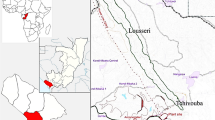Abstract
Direct gamma spectrometry study was carried out within and around the operational area of the Central Ashanti Gold of Ghana to ascertain the baseline radioactivity levels of naturally occurring radioactive materials (NORM), prior to processing of gold ore at the mine. The average activity concentrations of 238U, 232Th, 40K and 137Cs in the soil/rock samples were 64.3, 68.4, 1243.9 and 3.5 Bqkg−1, respectively. For the water samples, the average activity concentrations were 2.5, 2.6, 14.7 and 0.7 BqL−1 for 238U, 232Th, 40K and 137Cs, respectively. The total annual effective dose to the public was estimated to be 0.141 mSv which is below the ICRP recommended level of 1 mSv for public exposure control. The average radium equivalent activity value was 257.8 Bqkg−1 in the range of 72.9–402.3 Bqkg−1. The average values of external and internal indices were 0.7 and 0.8, respectively. The concentrations of U, Th and K were variable in soil and rock samples taken from different locations in the study area with values varying in the range of 0.8–10.9, 2.4–39.4 μg/g and 0.7–6.3 %, respectively. The concentration values of gross-α and gross-β for all the water samples were below the Ghana Standards Board and Who Health Organisation recommended guideline values for drinking water quality. The results obtained in this study shows that radiation levels are within the natural background radiation levels found in literature and compared well with similar studies for other countries.




Similar content being viewed by others
References
Alam MN, Miah MMH, Chowdhury MI, Kamal M, Ghose S, Islam MN, Mustafa MN, Miah MSR (1999) Radiation dose estimation from radioactivity analysis of lime and cement used in Bangladesh. J Environ Radioact 42:77–85
ASTM (1983) Standard method for sampling surface soils for radionuclides. American Society for Testing Materials, Report No. C (PA: ASTM), 983–998
ASTM (1986) Recommended practice for investigation and sampling soil and rock for engineering purposes. In: Annal Book of ASTM Standards (04/08), American Society for Testing Materials, Report No. D, 420 (PA: ASTM, 109–113
Beretka I, Mathew PI (1985) Natural radioactivity of Australian building materials, waste and by products. Health Phys 48(1):87–95
Darko EO, Faanu A (2007) Baseline radioactivity measurements in the vicinity of a gold treatment plant. J Applied Sci Tech (JAST) 10(1–2):45–51
Darko EO, Tetteh GK, Akaho EHK (2005) Occupational radiation exposure to norms in a gold mine. Rad Protect Dosim 114(4):538–545
Darko EO, Faanu A, Razak A, Emi-Reynolds G, Yeboah J, Oppon OC, Akaho EHK (2010) Public exposure hazards associated with natural radioactivity in open-pit mining in Ghana. Rad Prot Dosim 138(1):45–51
Faanu A, Ephraim JH, Darko EO (2010) Assessment of public exposure to naturally occurring radioactive materials from mining and mineral processing activities of Tarkwa Goldmine in Ghana. Environ Monit Assess. doi:10.1007/s10661-010-1769-9
Hamilton TF (1997) An investigation on the 137Cs content of soil collected from the Boeing North America, Inc., Employees’ recreational and fitness center in Canoga Park (CA). Technical Report
Higgy RH, El-Tahawy MS, Abdel-Fattah AT, Al-Akahawy UA (2000) Radionuclide content of building materials and associated gamma dose rates in Egyptian dwellings. J Environ Radioact 50:253–261
IAEA (1996) International basic safety standards for protection against ionising radiation and for the safety of radiation sources, safety series no. 115. IAEA, Vienna
ICRP (1991) 1990 recommendations of the international commission on radiological protection, ICRP publication 60. Pergamon Press, Oxford
ICRP (2007) 2006 recommendations of the international commission on radiological protection, ICRP publication 103. Pergamon Press, Oxford
Lin Yu-Ming L, Pei-Huo L, Ching-Jiang C, Ching-Chung H (1987) Measurement of terrestrial gamma radiation in Taiwan, Republic of China. J Health Phys 52(6):805–811
OECD/NEA (1979) Exposure to radiation from natural radioactivity in building materials, Report by NEA Group of Experts, Nuclear Energy Agency. OECD, Paris
Tzortzis M, Tsertos H (2004) Determination of thorium, uranium and potassium elemental concentrations in surface soils in Cyprus. J Environ Radioact 77:325–338
UNSCEAR (2000) Exposures from natural sources, 2000 Report to General Assembly, Annex B, New York
Uosif MAM (2007) Gamma–ray spectroscopic analysis of selected samples from the Nile river sediments in Upper Egypt. Rad Prot Dosim 123(2):215–220
WHO (2004) Guidelines drinking-water quality, vol 1 recommendations, 3rd edn. World Health Organization, Geneva
Xinwei L, Lingquig W, Xiaodan J, Leipeng Y, Gelian D (2006) Specific activity and hazards of Archeozoic-Cambrian rock samples collected from the Weibei area of Xhaanxi, China. Rad Prot Dosim 118(3):352–359
Acknowledgments
This work was carried out with the cooperation and support of management and staff of Central Ashanti Gold Ltd for which the authors are very grateful. All the analyses were carried out at the laboratories of the Radiation Protection Institute of the Ghana Atomic Energy Commission and the contributions from various members of staff is gratefully acknowledged. The sampling at the site of the Central Ashanti Gold Ltd was facilitated by Mr. Michael Sackey, the Manager in charge of Environment and the assistance offered by some his staff namely; Mr. Emmanuel Aidoo-Poku and Mr. Phanuel Sackey as well as Mr. Albert Quaye to gain access to various locations within the mine’s operational area is greatly appreciated.
Author information
Authors and Affiliations
Corresponding author
Rights and permissions
About this article
Cite this article
Faanu, A., Kpeglo, D.O., Sackey, M. et al. Natural and artificial radioactivity distribution in soil, rock and water of the Central Ashanti Gold Mine, Ghana. Environ Earth Sci 70, 1593–1604 (2013). https://doi.org/10.1007/s12665-013-2244-z
Received:
Accepted:
Published:
Issue Date:
DOI: https://doi.org/10.1007/s12665-013-2244-z




